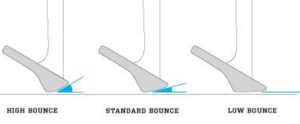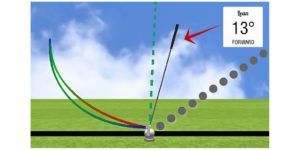
Many golfers aren’t familiar with what wedge bounce is, or even how to use it properly.
Wedge bounce can be your friend when it comes to chipping and pitching. Think of it like a backup plan if things go wrong. It can allow you to strike the ball properly even if your technique isn’t perfect.
If you speak with most club fitting experts they would say that most golfers stand to gain with wedges that have more bounce, but each player is different so it’s important to understand if bounce can help out your game.
What is wedge bounce?
Wedge bounce is the angle between the ground and the sole of the club when the club is held at a proper address.
Take a look at this picture to get a visual representation of what different kinds of bounces look like.

The whole point of bounce is to prevent theleading edge of your club from digging into the ground. This is where the concept of having it be your backup plan comes into play.
One of the biggest mistakes golfers make is that they hit the ball heavy with their wedges. Playing a club with enough bounce, and using it properly can prevent this from happening.
Which wedge bounce is right for you?
Most golfers don’t even know the amount of bounce they have on their wedges, but it’s actually quite important to get it right for the type of swing you have, and the conditions you play in.
If you are someone who plays on a course with very firm turf, then the rule of thumb is to play a wedge with less bounce. Additionally, players who have a shallow swing arc and who “pick” the ball clean, stand to benefit from a wedge with less bounce.
The reason for this is because you will have less of an issue with the club digging into the ground if the turf you are playing on is very firm or if you have a very shallow swing when you chip or pitch the ball.
Conversely, if you are playing on a course with softer conditions, or if you have a steeper angle of attack with your wedges, you will benefit from more bounce.
I tend to believe that many golfers fall into the latter category, and most stand to gain with a wedge that has a little bit more bounce, which will help prevent the club from digging.
How do you use bounce?
I love using the bounce of my wedge around the greens in certain situations, and especially when I’m in the rough. It helps my club slide underneath the ball, which gives me more control over the distance, and reduces my margin of error.
I believe there is one key to engage the bounce when playing these types of shots, and it has to do with shaft lean at impact (or how far your hands are ahead of the ball).
If your hands are way too far ahead you are essentially de-lofting the club and activating the leading edge of your wedge, which will eliminate the benefit of the bounce. This can result in the dreaded chunked shot, because the club will be digging into the ground before you make contact with the ball.
I’ve been working with my Swingbyte to help get a sense of how I am controlling my shaft lean on the different wedge shots I like to play. I’ve taken two different shots to illustrate how bounce can play a factor.
One is a low runner where I lean the shaft a bit more. I typically use this on tighter lies in the fairway where I have plenty of green to work with.

You can see that my swing arc is a bit shallow, and the handle of the club is ahead of the ball at impact. Swingbyte is measuring my shaft lean at about 13 degrees forward at impact. This type of swing is not really engaging the wedge bounce of my sand wedge at all. I need to make crisp contact in order for this to succeed.
Conversely, on the next swing you can see that my hands are less ahead of the ball at impact, and I have a steeper swing arc. That is the exact type of shot that uses the bounce.

I could actually stand to use a little bit less of shaft lean at impact, and this is something I am going to be working on. I really want that number to be closer to about 6-7 degrees.
When do you want to use bounce?
There are a few situations where bounce can help you or hurt you.
If you were on a tightly mowed fairway, and the turf was relatively firm, playing a shot with a high-bounce wedge can actually cause you to blade the ball.
However, these conditions are generally not common on the courses that most golfers are playing, which is why I tend to believe that using your bounce wherever you can is effective.
So if you want to start using the bounce of your wedge more on your chip and pitch shots, don’t lean your hands too far ahead of the ball as you address it. Additionally, you want to limit how far your hands are getting ahead of the ball at impact.
You have to let the bounce do its job, and too much shaft lean will prevent that from happening. A very simple swing thought is to feel like your hands will arrive to the ball at the same time as the club head.
A lot of the time it’s really hard to know exactly what we are doing with our technique, which is why working with a product like Swingbyte can show you what is actually happening. I am personally working on trying to limit my shaft lean at impact on shots where I'm trying to engage the bounce.
Wrapping it up
Take a look at your current wedges and see what kind of bounce you are playing with. If you are someone who is struggling with making crisp contact it might make sense to play a wedge with more bounce, and start thinking about some of the technique adjustments I discussed.
Remember, bounce can be your friend, and it will help reduce your margin of error around the greens. That is how you lower scores!
I'm also pleased to announce that our site was recently ranked in the top 50 by Golf Assessor!
We care about the protection of your data Read our Privacy Policy